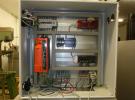Hello,
I am working on an art project where I need to read electric signals from plants and use them with a raspberry pi. I am sorry for the maybe stupid questions but I have no knowlege of electronics yet and this is a learning by doing project.
I bought this EI1040 to make the signals stronger. My first question is what kind of cables or plugs do i need to put in the ports?
I was suggested to use these eeg needles (Subdermal) they are coming with the cable you see on the picture. I dont know if I can plug them into the ports of the EI1040. Or what plugs I would need.
And how do i connect the ports of the EI1040 then to the USB-201 or the MCC 118/MCC 152 to digitalize it for my raspberry pi I mean what cables or plugs do I use?
And is the EI1040 just working with a battery? (I did not open it to look iside if there are batterys) Or do I need anything to make it run?
I hope someone can help me.



.png%3Fitok=PHGBxf6M)


.jpg%3Fitok=B1YcuDFK)
.png%3Fitok=Ybt-OlgU)
The EI1040 requires an external supply connected between + 5V In and GND In. You should be able to use the 5V pin and GND from the Pi for power if you do not have another power supply in mind.
For the connections, you ideally want wire (flying) leads for your probes. I am not sure how well the probes will work; I think if you can find a different sensor made for your desired purpose that would be preferable to trying to directly measure the potential between two leads. What are you trying to measure, and what is the end goal for the data?
With whatever leads you end up with and if you go with a setup as you currently described, you would want one to the "A" or "B" terminals, so one to A+ and one to A-, for example. You should also have a large resistor (maybe 100kΩ) between A- and GND to provide a path for the amp bias current to flow. The output would then be Aout, which you would connect to your measurement board AI, then also connect the measurement board GND to the amplifier GND. Our datasheet describes how to set the amp gain:
https://labjack.com/support/datasheets/accessories/ei-1040
Unfortunately, we are not familiar with the measurement boards you mentioned and I do not think we can help much with them. I would recommend contacting the manufacturer for assistance.
Also, we don't have specific experience with signals from plants, but I would guess they are quite difficult to measure for a couple reasons:
1. The voltage levels produced are small. You are addressing this with the EI-1040.
2. The signals have very high source impedance (i.e. very limited ability to source much current). The EI-1040 is enough for some high impedance signals, but others are too delicate and require a more specialized amp. In addition, the leads connecting your high impedance signal to the EI-1040 will act like an antenna and could pick up problematic noise from the environment.
3. Because they are delicate signals, you can easily get in a situation where you think you are getting good readings, but actually are just getting some sort of invalid readings that seem to look good at that moment. You will want to come up with strategies to validate your readings and show they are repeatable and consistent under different conditions.
I would definitely recommend you search for information from people who have successfully measured voltage signals from plants before.
I did a lot of research and found a science project that was done a few years ago. I could not get in touch with the scientists but they published the whole project. They used the EI-1040 for their thats why I chose it.
For my project I mainly need the data from the plant in my raspberry pi to work with it in a python program.
As I have no knowlege in electronics, my idea was just to copy that project. They have a picture thats like a map that shows in what ports i put the cables that come from the plant into the EI1040 and where I put cables to connect to the second device.
The second device I changed to one similar as they used with the same ports that just fits to a raspberry pi.
To keep noises out I have to build something like a Faraday cage around it.
I do not understand enough of electronics to do changes on the project. Or to choose better devices. I mainly want to copy their project as a learning process and then use the data i get in my program. Maybe in the future when I am more into it I would like to do changes or improve stuff.
For the power supply: I dont want to connect the El-1040 directly to the gpios of the raspberry. Do you have any suggstions for a battery or powerbank or something like that?
Most any 5V source should work okay, but you need to be able to break out the power to wire leads to input into the amp. Unfortunately, we do not have any particular recommendations. The amp was designed to be powered off of lines such as the VS lines on our data acquisition devices or the 5V supply on a Pi.